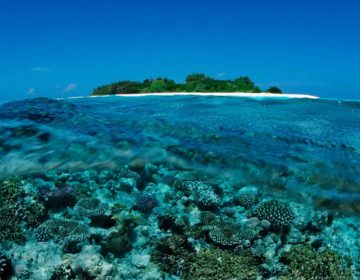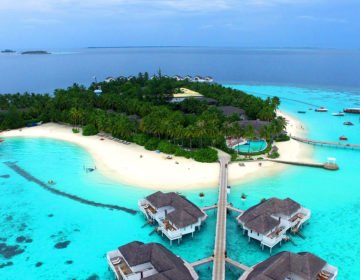The Malé Hukuru Miskiy, also known as the Malé Friday Mosque or the Old Friday Mosque is one of the oldest and most ornate mosques in Malé. Situated opposite the Medhuziyaaraiy, which is the tomb of Al-Hafiz Abul Yoosuf Al-Barbari of Morocco, who converted Maldives into Islam in 1153 AD, and the Muliaage in the heart of the city, the Hukuru Miskiy dates back to 1656 and has been added to the UNESCO World Heritage cultural list as a unique example of sea-culture architecture.
 Hukuru Miskiy dates back to 1656 and is listed on the UNESCO World Heritage cultural list as a unique example of sea-culture architecture.
Hukuru Miskiy dates back to 1656 and is listed on the UNESCO World Heritage cultural list as a unique example of sea-culture architecture.
History
Originally constructed in 1658 AD under the reign of Sultan Ibrahim Iskandar I, the ancient decorated Hukuru Miskiy mosque is built mostly out of coral stone. The mosque was built over an earlier mosque that was erected by the first Muslim Sultan of Maldives, Mohamed Bin Abdullah, in 1153 after his conversion to Islam. It is believed that the original mosque was refurbished by Ahmed Shihabuddeen in 1338, however, there are no written records attesting this.
In 1656, Sultan Ibrahim Iskandar I began building a new mosque to accommodate the increasing number of devotees when the old one became too small, and its construction, which took one-and-a-half years, was completed in 1658.
Built primarily of coral, the original mosque had a thatched roof, which was a typical style during the period and faced the setting sun, rather than Mecca. A munnaaru (minaret) and a gate at the southern end of the mosque were added by Ibrahim I after his 1668 Hajj, and the thatched roof and southern gateway were later replaced with corrugated-iron sheeting by Muhammad Shamsuddeen III in the early 1900s. The corrugated-iron roof was then replaced with aluminum, and the roof supports with teak wood in 1963.
Surrounded by a 17th-century cemetery with intricately-carved tombstones and mausoleums, the minaret at the mosque is patterned on those at the entrance to Mecca. In 1987 and 1988, an Indian team from the National Research Laboratory for Conservation of Cultural Property and the National Centre for Linguistic and Historical Research in Malé did conservation work on the mosque.[1]
Boasting a perimeter of 199 feet, Hukuru Miskiy’s main building, which is still used for conducting the daily prayers is divided into three sections, namely Mihuraabuge- the room or section used by the Imam in leading the prayers; Medhu Miskiy – the middle Mosque; and Fahu Miskiy – the back Mosque.
Features
Set in a walled enclosure, the Malé Friday Mosque is constructed of interlocking coral blocks with a hypostyle roof supported by cut-coral columns and has walls inscribed with intricate carvings and inscriptions in Quranic script. The mosque is oriented west, and its prayer carpet is angled towards the mosque’s northwest corner, so worshippers can face Mecca while they pray. Two entrance gates that lead to the mosque balcony allow devotees to enter the mosque from either side and the mosque has two prayer halls surrounded by antechambers on three sides. The mosque has a high vaulted, stepped and intricately decorated ceiling with beautiful, culturally-significant carvings fashioned by local master carpenters, known as maavadikaleyge.
 The mosque has a high vaulted, stepped and intricately decorated ceiling with beautiful, culturally-significant carvings fashioned by local master carpenters, known as maavadikaleyge.
The mosque has a high vaulted, stepped and intricately decorated ceiling with beautiful, culturally-significant carvings fashioned by local master carpenters, known as maavadikaleyge.
The mosque’s main prayer hall has a burgundy-colored carpet, patterned with images resembling hot-water bottles which demarcate spaces for the believers offering prayers. The carpet can accommodate 1,372 people if each devotee occupies one space and the mosque has a capacity of approximately 10,700 for Friday prayers.
The main building is divided into three sections, namely the mihrab (the area used by the imam to lead the prayers), the medhu miskiy (the central area in the mosque), and the fahu miskiy (the rear section of the mosque). The mihrab is a large chamber with a mimbar (pulpit) at one end.
Built in 1675 and resembling a wedding cake, the mosque’s adjoining large, round blue-and-white squat minaret, the munnaaru, has a wide base similar to a ship’s funnel that is constructed out of coral stones and braced with metal strips. The minaret is surrounded by a graveyard with carved coral tombstones, distinguishing males, females, sultans and their families by their distinctive shapes. Men’s tombstones have pointed tops; women’s tombstones have rounded tops, and family members have small mausoleums with intricately-decorated stone walls.
 The minaret is surrounded by a graveyard with carved coral tombstones.
The minaret is surrounded by a graveyard with carved coral tombstones.
Lacquerwork
The interior is superb and famed for its exquisite detailing. It many valuable samples of traditional Maldivian art in the form of woodcarving and lacquer work in panels and ceilings. A long, carved 13th-century panel commemorates the introduction of Islam to the Maldives.
 The mosque features exquisite detailing.
The mosque features exquisite detailing.
Visitors
Non-Muslims wishing to see inside are supposed to get permission from an official of the Ministry of Islamic Affairs. Most of the staff are officials of the ministry, however, and so if you are conservatively dressed, and its outside prayer times, you may well get permission to enter on the spot. Respectably dressed non-Muslims are welcome to walk around the graveyard; you don’t require consent for this.
Getting There
The Old Friday Mosque is an eight-minute walk from the Hulhumale’ Ferry Terminal in Malé via Boduthakurufaanu Magu and Medhuziyaarai Magu. You can also take bus number 101 to Sultan Park Bus-Station. The Old Friday Mosque is 170 m from Sultan Park Bus-Station.



